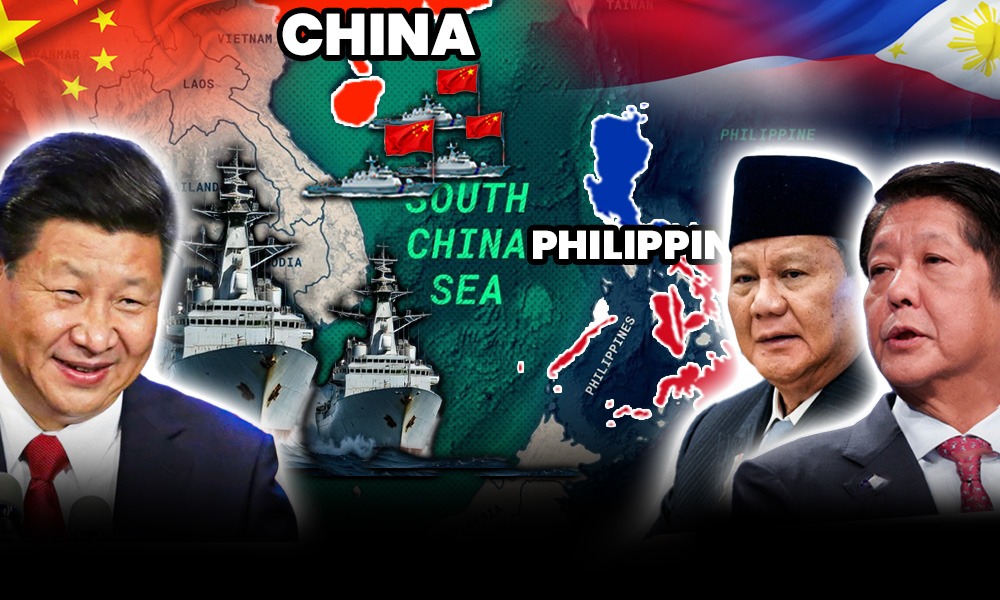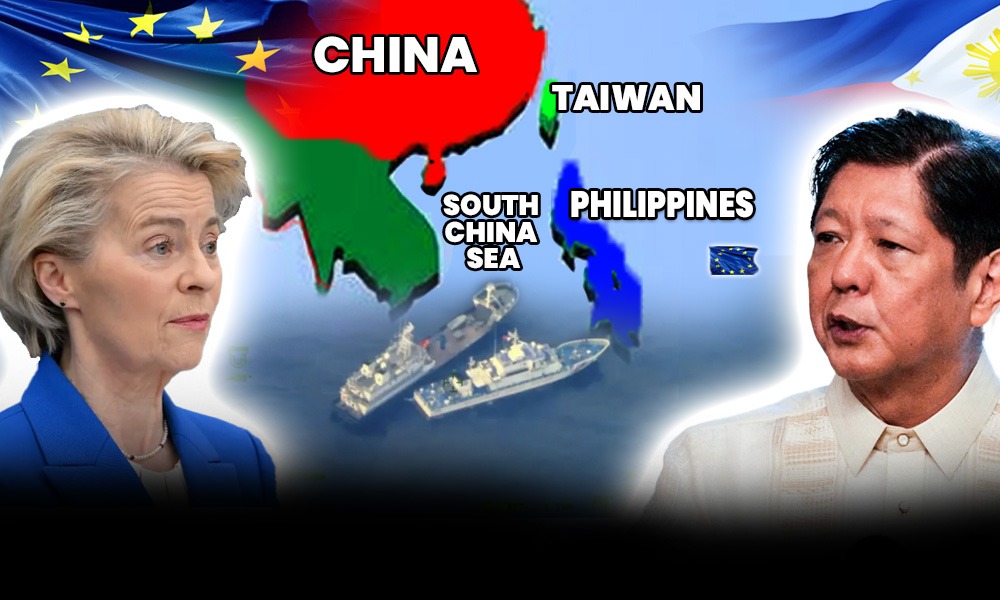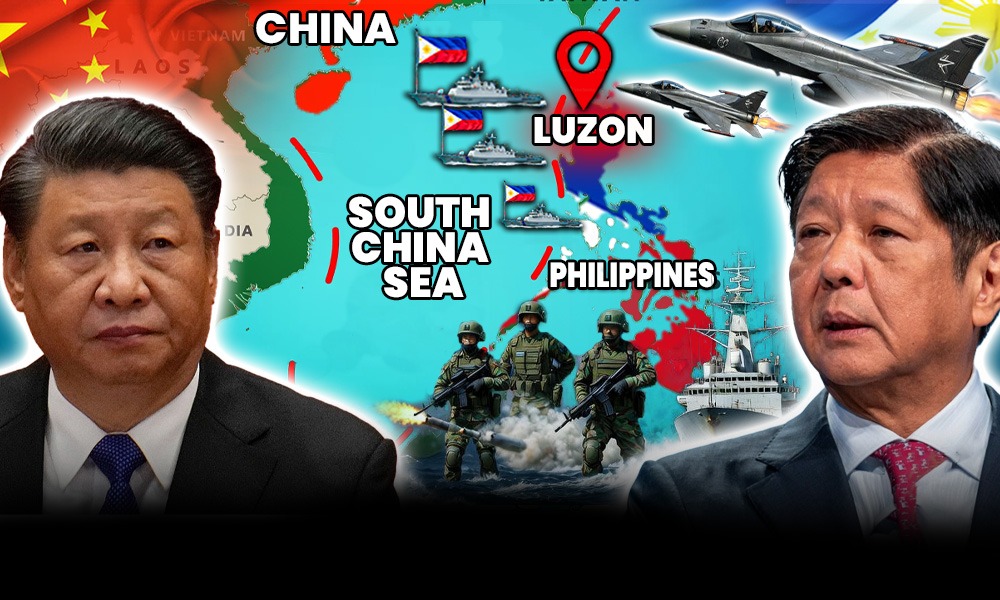The Philippines has shaken the entire Indo-Pacific security landscape with its unprecedented “transparency initiative,” a bold strategy that turns every Chinese gray-zone maneuver into a global spectacle. What were once quiet maritime confrontations, foggy reports of rammings, blocked resupply missions, and laser harassment, are now blasted across international media in real time. Manila has mastered the art of exposing coercion, transforming raw footage into diplomatic ammunition and forcing Beijing to defend its actions on the world stage. It is, as one analyst put it, “a battlefield where the camera is the weapon.”
And yet, in striking contrast, Indonesia, Southeast Asia’s largest nation, a maritime powerhouse, and one of the first to openly reject the Nine-Dash Line, still refuses to adopt the Philippine model. Despite facing its own intrusions in the North Natuna Sea, from Chinese survey ships to maritime militia swarms, Jakarta avoids confrontation-by-publicity. Instead, it maintains a careful, measured silence: limited statements, quiet coast guard deployments, and discreet diplomatic notes that rarely make global headlines.
To outside observers, this restraint raises a stubborn question: Why is Indonesia staying silent when the Philippines is gaining support by speaking loudly? How can two democracies face the same pressure yet pursue such opposite strategies? The answer is rooted in four powerful, interconnected realities that shape Indonesia’s strategic calculus.
First, Indonesia’s economic dependency on China is immense and growing, billions in annual investment, dominance in trade, and critical projects like nickel processing and the Jakarta–Bandung High-Speed Rail. Publicly shaming Beijing risks jeopardizing growth, jobs, and national development goals tied to foreign capital.
Second, Jakarta’s foreign policy DNA is fundamentally different. Guided by a Javanese philosophy of “winning without shaming,” Indonesia habitually avoids megaphone diplomacy. Its identity as ASEAN’s mediator and its role in shepherding the South China Sea Code of Conduct, depends on maintaining calm neutrality, not front-line activism.
Third, under the new administration, Indonesia is leaning into pragmatic engagement. Proposals like “joint development” in the North Natuna Sea signal a willingness to cooperate economically even where legal consistency becomes blurred. For Jakarta, stability and growth outweigh public confrontation.
Finally, the nature of the dispute itself differs. The Philippines battles China over sovereignty of land features, military outposts, reefs, and shoals, where confrontations are violent, dramatic, and inherently visual. Indonesia, by contrast, deals with EEZ enforcement and illegal fishing cases, serious but less cinematic, less legally explosive, and less politically compelling for a global transparency campaign.
These factors reveal a deeper truth about Southeast Asia’s strategic landscape: while the Philippines uses transparency as a shield and amplifier, Indonesia sees silence as a buffer and stabilizer. Manila aims to gain allies; Jakarta avoids escalation to preserve economic security and regional influence. In a region caught between economic dependence and maritime vigilance, the question lingers: Is Indonesia’s quiet diplomacy a wise strategy for long-term stability or a dangerous bet that risks normalizing China’s pressure?
Overriding Economic Dependency and Investment Leverage
Indonesia’s refusal to mirror the Philippines’ transparency strategy begins with one unavoidable reality: its economy is deeply intertwined with China’s, to a degree far exceeding that of almost any other Southeast Asian nation. In 2024 alone, Chinese foreign direct investment into Indonesia surged to an estimated US$8.1 billion, a staggering increase that reflects not just temporary capital flows but an entrenched structural dependency. China remains Indonesia’s largest trading partner and second-largest investor, a position it has maintained for years, giving Beijing unparalleled economic leverage over Jakarta’s strategic decisions. This relationship goes far beyond simple trade; it is embedded in Indonesia’s most critical infrastructure and industrial ambitions.
Some of Indonesia’s flagship national projects, those that the government proudly showcases as symbols of modernization, are built with Chinese money, Chinese technology, and Chinese oversight. The Jakarta–Bandung High-Speed Rail, Southeast Asia’s first bullet train, is perhaps the most visible example, but it is only the tip of the iceberg. Chinese companies dominate Indonesia’s rapidly expanding nickel and electric vehicle battery sector, an industry Jakarta considers essential to its economic future. These long-term, capital-intensive partnerships make any political confrontation with China doubly risky: not only could Beijing retaliate economically, but Indonesia’s own development trajectory could be disrupted.
It is therefore not surprising that Indonesia ranked 7th out of 101 countries in the 2024 China Index for overall exposure, an index that evaluates a country’s economic, political, and technological vulnerability to Chinese influence. A high score does not imply subservience, but it does signal how costly any diplomatic escalation could become. Indonesian officials are acutely aware that transparency campaigns, like the Philippines uses, tend to anger Beijing and can prompt economic pushback. For a nation heavily dependent on external investment to sustain high economic growth targets of 5–7% annually, such a risk is strategically unacceptable.
And this is where the internal trade-off becomes clear: Indonesia quietly weighs sovereignty against economic growth, and for now, growth wins. The government’s priority is maintaining investor confidence, expanding industrial capacity, and keeping development on track. Publicly exposing Chinese incursions may offer short-term diplomatic leverage, but it could jeopardize billions in investments and the political stability anchored to them. In Jakarta’s strategic calculus, the economic consequences of adopting Manila’s transparency model simply outweigh the symbolic gains, making silence not a sign of weakness, but a deliberate economic safeguard.
Diplomatic Tradition: Prioritizing Quiet Engagement and ASEAN Unity
Indonesia’s refusal to embrace the Philippines’ “megaphone diplomacy” is also rooted in a deeply embedded political culture: a diplomatic tradition that values quiet engagement over public confrontation. At the heart of this mindset lies the Javanese principle of menang tanpa ngasorake “to win without shaming the opponent.” This philosophy, which subtly shapes Indonesian statecraft, encourages firmness without humiliation, negotiation without theatrics, and assertion of rights without risking a loss of face for the other side. In practice, this means Jakarta prefers to handle disputes through backchannels and controlled messaging rather than through viral videos, press briefings, or public condemnation. The goal is to secure outcomes while avoiding unnecessary escalation.
One of the clearest examples of this approach unfolded during the 2021 standoff at the Tuna Block in the North Natuna Sea, where a Chinese survey vessel shadowed an Indonesian-licensed oil drilling operation for weeks. Unlike Manila, which would have broadcast each maneuver on social media or invited foreign press for briefings, Jakarta opted for silence. No dramatic press conferences. No daily updates. No naming and shaming. Critics called it passive, but the outcome suggested otherwise: Premier Oil successfully completed its drilling, Indonesian rights were upheld, and Beijing quietly withdrew without a diplomatic spectacle. Indonesian officials privately point out that Vietnam, which took a more confrontational approach in a similar situation, suffered delays and Chinese pushback. In Jakarta’s eyes, quiet diplomacy works, not because it avoids conflict, but because it prevents China from feeling cornered and reacting aggressively.
This preference for subtlety is also tied to Indonesia’s self-image as ASEAN’s natural leader and mediator. Unlike the Philippines, which openly aligns with Western partners and leans into adversarial messaging, Indonesia sees itself as the region’s “honest broker” a country that can speak to all sides, bridge disagreements, and champion collective interests. Jakarta has long led discussions on the ASEAN–China Code of Conduct (CoC), a delicate diplomatic effort that requires trust, neutrality, and a reputation for restraint. Launching a transparency initiative like the Philippines’ which is inherently confrontational, could undermine that reputation and portray Indonesia as breaking ASEAN unity. Such a move could also reduce ASEAN’s bargaining leverage by appearing unilateral rather than consensus-based.
In this sense, transparency is not just a communication strategy; it is a diplomatic identity shift, one Indonesia is unwilling to make. To Jakarta, publicizing every Chinese action would jeopardize the quiet channels of influence it has built over decades and weaken its position as ASEAN’s main stabilizing force. As a result, Indonesia sticks to a softer, quieter form of assertiveness, not out of fear, but out of a belief that regional diplomacy is better served by calm voices rather than loud confrontations.
https://www.youtube.com/watch?v=zuTySN8aZgg
New Administration’s Pragmatic Policy Shift (Prabowo Subianto)
A major reason Indonesia will not mirror the Philippines’ transparency initiative lies in the new strategic direction set under President Prabowo Subianto, whose approach is notably more pragmatic, transactional, and development-focused. Rather than emphasizing legal confrontation or public pressure, Prabowo has signaled a willingness to pursue “practical cooperation” with Beijing, even in areas where Indonesia holds clear-cut sovereign rights under international law. This shift was most visible when, shortly after his election, he proposed a “joint development” arrangement with China in what he called the “overlapping maritime area” of the North Natuna Sea. The phrasing itself was controversial: under UNCLOS, there is no legally recognized overlap, Indonesia has full sovereign rights over the area. Yet Prabowo framed the idea in strikingly pragmatic terms, saying, “We respect each other’s legal position, but in the meantime, why don’t we work together?” For critics, this raises the alarm that Indonesia’s new policy risks creating the illusion of a dispute where none exists, subtly validating China’s expansive nine-dash-line claims. But for Prabowo, the priority appears to be stability, cooperation, and economic opportunity over rigid legal posturing.
This pragmatism becomes clearer when viewed alongside Prabowo’s economic agenda. His November 2024 visit to Beijing resulted in massive cooperation commitments reportedly worth around US$10 billion, covering investments, infrastructure, technology, and energy. These deals were not merely diplomatic gestures, they were strategic lifelines for Indonesia’s ambitious development programs, including industrialization, downstream mineral processing, and large-scale infrastructure. A more confrontational posture toward China, such as adopting a transparency initiative like the Philippines, could jeopardize these opportunities. For Prabowo, whose administration aims to accelerate economic growth and secure Indonesia’s long-term development trajectory, the risks of antagonizing Beijing outweigh the symbolic value of naming and shaming Chinese vessels. Thus, Jakarta’s hesitance to publicly document every Chinese incursion is not a sign of weakness but a calculated choice shaped by the leadership’s preference for economic stability over legal absolutism, and by a belief that cooperation, even in contentious areas, can yield mutual benefits without triggering geopolitical backlash.
Indonesia’s new political direction under Prabowo is built on a simple but consequential principle: pragmatism first, confrontation last. This philosophy naturally clashes with the Philippines’ far more confrontational transparency strategy, making it highly unlikely for Jakarta to adopt similar tactics anytime soon.
Philippines Launches Massive Anti-Invasion Drills in Northern Luzon and South China Sea
Fundamental Difference in the Nature of the Dispute
Another key reason Indonesia will not adopt the Philippines’ transparency model lies in the fundamental difference between the two countries’ disputes with China. While Manila and Jakarta both face pressure from Beijing, the type of conflict they are dealing with is not the same, and this difference directly shapes their strategic responses. For the Philippines, the conflict involves sovereignty over islands and reefs, military posturing, and direct attacks on Filipino personnel. For Indonesia, the issue is primarily about fishing rights and EEZ enforcement, serious, but far less dramatic, less visual, and far less likely to mobilize international outrage. These contrasting realities create two very different incentives: the Philippines must expose aggression to defend its sovereign claims, while Indonesia sees little strategic gain in amplifying incidents that do not fundamentally threaten its territorial integrity.
For Manila, the situation is existential because it revolves around contested features such as the Spratly Islands (Kalayaan Island Group) and Scarborough Shoal. China is not merely intruding, it is attempting to cement de facto control over islands that the Philippines legally claims. The stakes are highest at places like Second Thomas Shoal, where Filipino Marines stationed aboard the grounded BRP Sierra Madre endure constant harassment. Here, China’s actions are inherently visible and provocative: high-powered water cannons, dangerous ramming, military-grade blinding lasers, and aggressive maneuvers by the China Coast Guard. These confrontations produce dramatic footage, emotional stories, and undeniable evidence that Manila can weaponize diplomatically. Transparency, for the Philippines, isn’t optional, it is a survival tool to rally allies, shame Beijing, and prevent China from rewriting sovereignty facts on the water.
Indonesia’s experience in the North Natuna Sea is profoundly different. Unlike the Philippines, Jakarta is not a claimant in the Spratly Islands, nor does it face Chinese construction, military blockades, or attempts to seize physical features. Its dispute with Beijing is purely about China’s illegal nine-dash-line claims overlapping with Indonesia’s Exclusive Economic Zone (EEZ). Most incidents in the area involve illegal, unreported, and unregulated (IUU) fishing, a serious maritime governance issue, but not one that generates dramatic visuals. In 2025, Indonesia recorded a 12% rise in illegal fishing incidents, many involving Chinese vessels, but these events rarely escalate into collisions, rammings, or assaults. They lack the visceral impact needed for a sustained transparency campaign. Without the kind of high-intensity confrontations faced by the Philippines, Indonesia sees no compelling diplomatic or strategic advantage in “broadcasting” these events.
In short, Manila fights for islands; Jakarta fights for fisheries. One battle demands global attention; the other is best handled through quiet enforcement and diplomacy. This structural difference in the nature of their disputes ensures that Indonesia’s response will remain fundamentally different and far less public, than that of the Philippines.
https://indopacificreport.com/philippines-teams-up-with-east-timor-against-china-south-china-sea/
Conclusion: Contrasting Paths to Sovereignty
In the end, Indonesia’s refusal to mirror the Philippines’ transparency campaign is not hesitation, it is calculation. Where Manila chooses to shine a spotlight, Jakarta opts to dim the lights. The Philippines broadcasts every clash, every ramming, every water cannon blast to expose China’s overreach and rally allies to its side. Indonesia, by contrast, leans on quiet diplomacy, economic pragmatism, and the strategic belief that disputes are best managed behind closed doors, not megaphones. Their approaches diverge not because one cares more about sovereignty than the other, but because both are responding to very different pressures with the tools they believe best protect their national interests.
Jakarta’s path is shaped by powerful incentives: the US$8.1 billion annual flow of Chinese investments it cannot afford to jeopardize, the cultural principle of menang tanpa ngasorake, winning without humiliating the opponent, and President Prabowo’s willingness to propose joint development in waters that legally belong to Indonesia alone. These factors lock Indonesia into a diplomatic posture that avoids public confrontation, even at the cost of legal ambiguity.
But this strategic restraint comes with a price. By keeping quiet and engaging bilaterally, Indonesia secures economic stability today but risks normalizing China’s expansive nine-dash-line narrative tomorrow. Meanwhile, the Philippines embraces a high-risk, high-reward strategy: transparency as deterrence, exposure as defense. Manila has chosen global scrutiny; Jakarta has chosen silent endurance.
Both paths aim to protect national interests. Only time will reveal which strategy better safeguards sovereignty in a sea where silence can be misread as consent and where speaking out can be the only shield a small nation has.
https://indopacificreport.com/philippine-marines-brahmos-missiles-counter-china-aggression/



